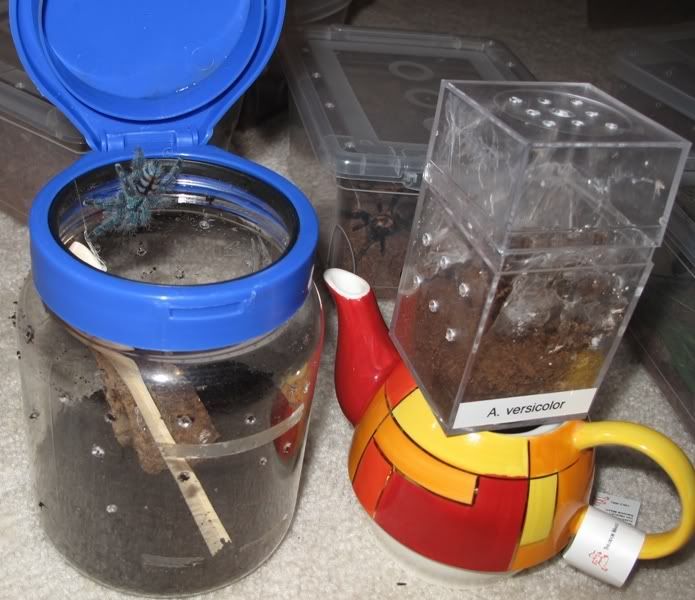thruthetrees
Arachnosquire
- Joined
- May 9, 2011
- Messages
- 107
I went to the Bug Fair in Los Angeles yesterday and ended up with two slings... I'm a first time owner--I got a Suntiger (against their advice as a first time T...  it was too pretty to not get
it was too pretty to not get  I know I will do just fine with it though...) And, a Chaco Golden Knee... Sorry, I don't have the scientific names in front of me... I'll be getting a Versicolor sling this week as well
I know I will do just fine with it though...) And, a Chaco Golden Knee... Sorry, I don't have the scientific names in front of me... I'll be getting a Versicolor sling this week as well 
The Chaco is around 1/2" (it's FAT butt is probably 1/4") and it's in a very small/shallow sauce cup (maybe 2" diameter 1" tall). It seems way too small so I want to rehouse her. Here's a bad shot of current set up (there's a lid for this--just off for photo... I put a guitar pick for a little size reference..):
http://farm3.static.flickr.com/2524/5724683200_80508974c8_b.jpg
The Suntiger is around 1.5" in a bigger deli cup which seems like a fine size but there's only 1/4" of substrate and nothing for her to hide or climb on... Here is her current set up:
http://farm3.static.flickr.com/2317/5724130109_d63133ba54_b.jpg
Questions:
I was told at the Fair that I cannot use a "kritter keeper" to house the T because of the "slats" on top... Is that true for only the Suntiger or both?
I haven't seen the Chaco climb the container it's in--not sure if it's just too short or if it cannot climb the way the Suntiger does... Is the small size kritter keeper (aka plastic "funarium") ok or is that too big for the Chaco? I cleaned out a deli cup thats a similar size to what the Suntiger is in... Would that be better?
What can I do about the Suntiger's current house? Not sure if I should/can put stuff in there? Or, should I wait til I move her into another more permanent house?
I read that I could get coco coir and sphagnum moss from Home Depot to use for T substrate... I am not sure if I got the right stuff--the moss isn't fine/ground up the way it looked in pet stores--I can cut it up but I wanted to make sure that was okay first... And, the coco coir is like a mat that you can cut to put in plant pots--I could also break it apart and cut it... Both have no additives... Are either ok? Is there something better (like the pet shop stuff)?
I live in So Cali--I read that the Suntiger likes 80-85F I am in a canyon that stays a lot cooler than most of the area... Do I need a heat mat for it?
I will take some better pictures of them once I get them more situated... Thanks for your help!!!
Thanks for your help!!!
:clap:
The Chaco is around 1/2" (it's FAT butt is probably 1/4") and it's in a very small/shallow sauce cup (maybe 2" diameter 1" tall). It seems way too small so I want to rehouse her. Here's a bad shot of current set up (there's a lid for this--just off for photo... I put a guitar pick for a little size reference..):
http://farm3.static.flickr.com/2524/5724683200_80508974c8_b.jpg
The Suntiger is around 1.5" in a bigger deli cup which seems like a fine size but there's only 1/4" of substrate and nothing for her to hide or climb on... Here is her current set up:
http://farm3.static.flickr.com/2317/5724130109_d63133ba54_b.jpg
Questions:
I was told at the Fair that I cannot use a "kritter keeper" to house the T because of the "slats" on top... Is that true for only the Suntiger or both?
I haven't seen the Chaco climb the container it's in--not sure if it's just too short or if it cannot climb the way the Suntiger does... Is the small size kritter keeper (aka plastic "funarium") ok or is that too big for the Chaco? I cleaned out a deli cup thats a similar size to what the Suntiger is in... Would that be better?
What can I do about the Suntiger's current house? Not sure if I should/can put stuff in there? Or, should I wait til I move her into another more permanent house?
I read that I could get coco coir and sphagnum moss from Home Depot to use for T substrate... I am not sure if I got the right stuff--the moss isn't fine/ground up the way it looked in pet stores--I can cut it up but I wanted to make sure that was okay first... And, the coco coir is like a mat that you can cut to put in plant pots--I could also break it apart and cut it... Both have no additives... Are either ok? Is there something better (like the pet shop stuff)?
I live in So Cali--I read that the Suntiger likes 80-85F I am in a canyon that stays a lot cooler than most of the area... Do I need a heat mat for it?
I will take some better pictures of them once I get them more situated...
:clap:

